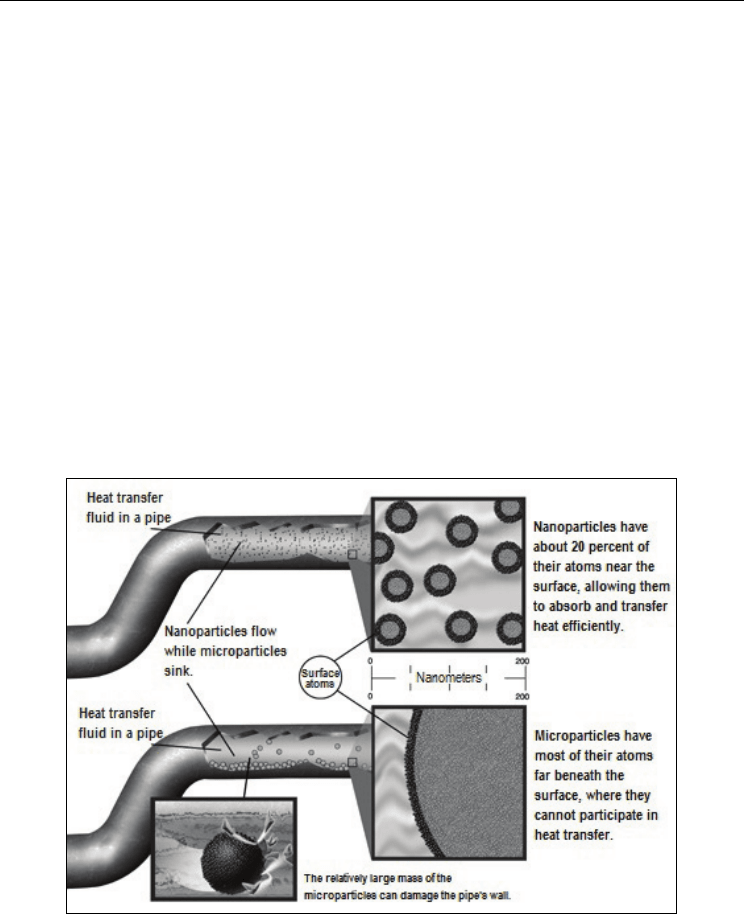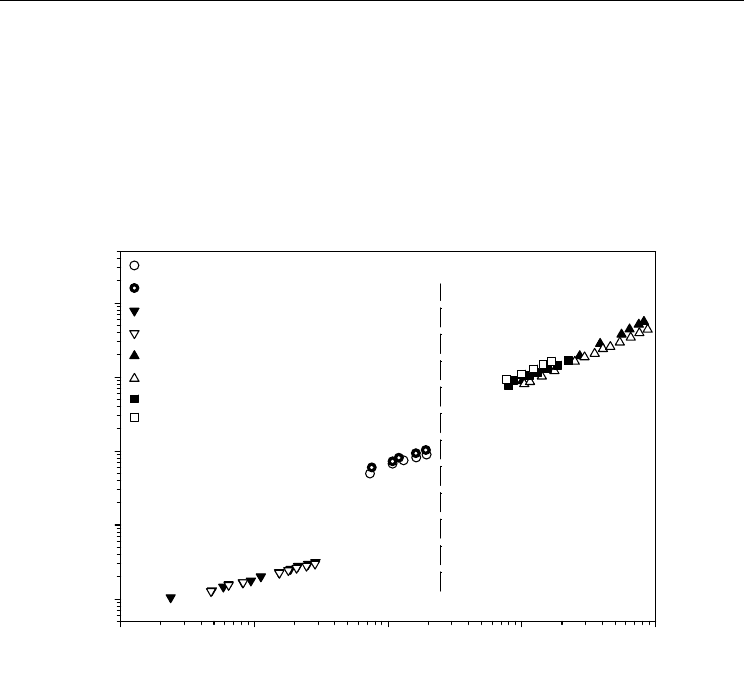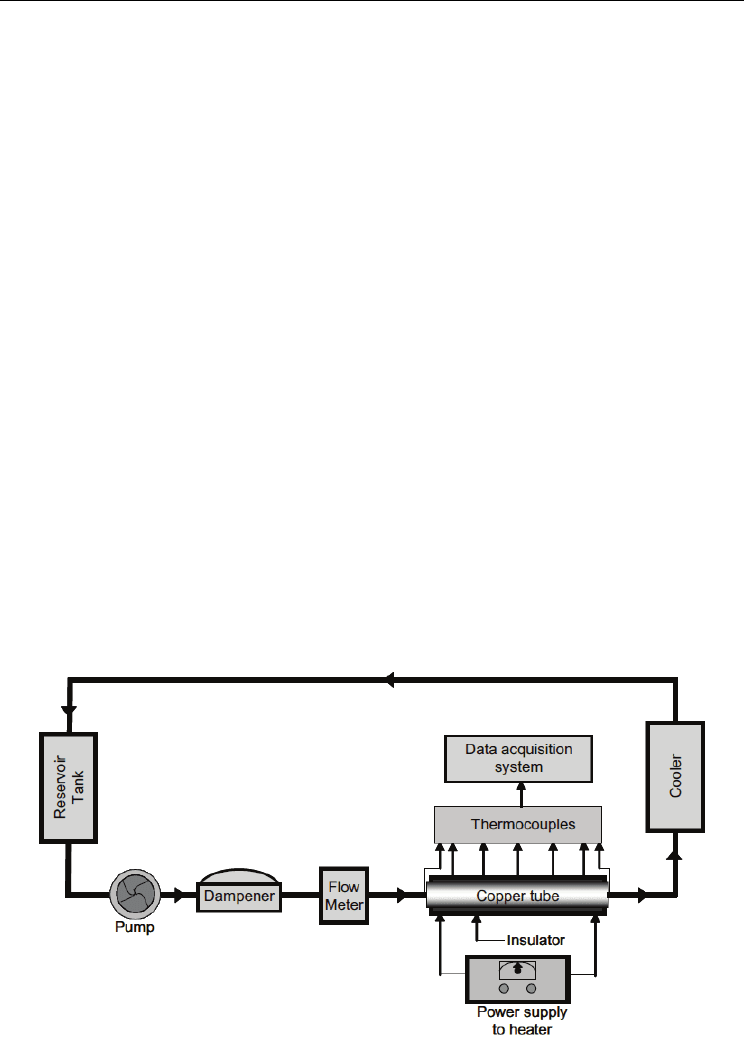Ahsan A. Two Phase Flow, Phase Change and Numerical Modeling
Подождите немного. Документ загружается.

18
Forced Convective Heat Transfer
of Nanofluids in Minichannels
S. M. Sohel Murshed and C. A. Nieto de Castro
Centre for Molecular Sciences and Materials
Faculty of Sciences of the University of Lisbon
Portugal
1. Introduction
Nanofluids are a new class of heat transfer fluids which are engineered by dispersing
nanometer-sized metallic or non-metallic solid particles or tubes in conventional heat
transfer fluids such as water, ethylene glycol, and engine oil. This is a rapidly emerging
interdisciplinary field where nanoscience, nanotechnology, and thermal engineering meet.
Since this novel concept of nanofluids was innovated in the mid-last decade (Choi, 1995),
this research topic has attracted tremendous interest from researchers worldwide due to
their fascinating thermal characteristics and potential applications in numerous important
fields such as microelectronics, transportation, and biomedical.
With an ever-increasing thermal load due to smaller features of microelectronic devices and
more power output, cooling for maintaining desirable performance and durability of such
devices is one of the most important technical issues in many high-tech industries. Although
increased heat transfer can be achieved creating turbulence, increasing heat transfer surface
area and other way, the heat transfer performance will ultimately be limited due to the low
thermal properties of these conventional fluids. If extended heating surface is used to obtain
high heat transfer, it also undesirably increases the size of the thermal management system.
Thus, these conventional cooling techniques are not suitable to meet the cooling demand of
these high-tech industries. There was therefore a need for new and efficient heat transfer
liquids that can meet the cooling challenges for advanced devices as well as energy
conversion-based applications and the innovation of nanofluids has opened the door to
meet those cooling challenges.
In the field of heat transfer, all liquid coolants currently used at low and moderate
temperatures exhibit very poor thermal conductivity and heat storage capacity resulting in
their poor convective heat transfer performance. Although thermal conductivity of a fluid
plays a vital role in the development of energy-efficient heat transfer equipments and other
cooling technologies, the traditional heat transfer fluids possess orders-of-magnitude
smaller thermal conductivity than metallic or nonmetallic particles. For example, thermal
conductivities of water and engine oil are about 5000 times and 21000 times, respectively
smaller than that of multi-walled carbon nanotubes (MWCNT) as shown in Table 1 which
provides values of thermal conductivities of various commonly used liquids and
nanoparticle materials at room temperature. Therefore, the thermal conductivities of fluids

Two Phase Flow, Phase Change and Numerical Modeling
420
that contain suspended metallic or nonmetallic particles or tubes are expected to be
significantly higher than those of traditional heat transfer fluids. With this classical idea and
applying nanotechnology to thermal fluids, Steve Choi from Argonne National Laboratory
of USA coined the term “nanofluids” to designate a new class of heat transfer fluids (Choi,
1995). From the investigations performed thereafter, nanofluids were found to show
considerably higher conductive, boiling, and convective heat transfer performances
compared to their base fluids (Murshed et al., 2005, 2006, 2008a, 2008b & 2011; Das et al.,
2006, Murshed, 2007; Yu et al., 2008). These nanoparticle suspensions are stable and
Newtonian and they are considered as next generation heat transfer fluids which can
respond more efficiently to the challenges of great heat loads, higher power engines,
brighter optical devices, and micro-electromechanical systems (Das et al., 2006; Murshed et
al., 2008a).
Although significant progress has been made on nanofluids, variability and
controversies in the heat transfer characteristics still exist (Keblinski et al., 2008; Murshed et
al., 2009).
Conventional Fluids
and Materials
Thermal Conductivity
(W/m·K)
Reference
Deionized water (DIW) 0.607 Kaviany, 2002
Ethylene glycol 0.254 Kaviany, 2002
Engine oil 0.145 Kaviany, 2002
Fe
3
O
4
7.2 Slack,1962
TiO
2
8.4 Masuda et al., 1993
CuO 13.5 Lide, 2007
Al
2
O
3
40 Slack,1962
Al 237 Lide, 2007
Cu 401 Lide, 2007
Ag 429 Lide, 2007
MWCNT 3000 Kim et al., 2001
Table 1. Thermal conductivities of commonly used liquids and materials at room
temperature
As the heat transfer performance of heat exchangers or cooling devices is vital in numerous
industries, the impact of nanofluids technology is expected to be great. For example, the
transport industry has a need to reduce the size and weight of vehicle thermal management
systems and nanofluids can increase thermal transport of coolants and lubricants. When the
nanoparticles are properly dispersed, nanofluids can offer numerous benefits besides their
anomalously high thermal conductivity. These benefits include improved heat transfer and
stability, microchannel cooling without clogging, miniaturized systems and reduction in
pumping power. The better stability of nanofluids will prevent rapid settling and reduce
clogging in the walls of heat transfer devices. The high thermal conductivity of nanofluids
translates into higher energy efficiency, better performance, and lower operating costs. They
can reduce energy consumption for pumping heat transfer fluids. Miniaturized systems
require smaller inventories of fluids where nanofluids can be used. In vehicles, smaller
components result in better gasoline mileage, fuel savings, lower emissions, and a cleaner

Forced Convective Heat Transfer of Nanofluids in Minichannels
421
environment (Murshed et al., 2008a). In addition, because heat transfer takes place at the
surface of the particles, it is desirable to use particles with larger surface area. The much
larger relative surface areas of nanoparticles compared to micro-particles, provide
significantly improved heat transfer capabilities. Particles finer than 20 nm carry 20% of
their atoms on their surface, making them instantaneously available for thermal interaction
(Choi et al., 2004). Fig. 1 demonstrates that nanoparticles are much better than
microparticles in applications (Murshed, 2007). With dispersed nanoparticles, nanofluids
can flow smoothly through mini- or micro-channels. Because the nanoparticles are small,
they weigh less and chances of sedimentation are also less making nanofluids more stable.
With the aforementioned highly desirable thermal properties and potential benefits,
nanofluids are considered to have a wide range of industrial and medical applications such
as transportation, micromechanics and instrumentation, heating-ventilating and air-
conditioning systems, and drug delivery systems. Details of the enhanced thermophysical
properties, potential benefits and applications of nanofluids can be found elsewhere (Choi et
al., 2004; Das et al., 2006; Yu et al., 2008; Murshed, 2007; Murshed et al., 2008a). As of today,
researchers have mostly focused on anomalous thermal conductivity of nanofluids.
However, comparatively few research efforts have been devoted to investigate the flow and
convective heat transfer features of nanofluids which are very important in order to exploit
their potential benefits and applications.
Fig. 1. Comparison between nanoparticles and microparticles flowing in channel
The aim of this chapter is to analyze experimental findings on forced convective heat
transfer with nanofluids from literature together with representative results from our
experimental investigation on heat transfer characteristics of aqueous TiO
2
-nanofluids
flowing through a cylindrical minichannel. Effects of Reynolds number and concentration of
nanoparticles on the heat transfer performance are also reported and discussed.

Two Phase Flow, Phase Change and Numerical Modeling
422
2. Literature survey on convective heat transfer with nanofluids
As mentioned before compared to the studies on thermal conductivity, efforts to investigate
convective heat transfer of nanofluids are still scarce. For example, according to ISI Web of
Knowledge searched results, only 222 convective heat transfer-related publications out of
1363 recorded publications on nanofluids appeared (publications including journal and
conference papers, patent, news and editorial and searched by topic “nanofluids” and
refined by topic “convective heat transfer” on 12 April 2011). However, the practical
applications of nanofluids as advanced heat transfer fluids or cooltants are mainly in
flowing systems such as mini- or micro-channels heat sinks and miniaturized heat
exchangers. A brief review of forced convective studies (experimental and theoretical) with
nanofluids is presented in this section.
The first experiment on convective heat transfer of nanofluids (γ-Al
2
O
3
/water and
TiO
2
/water) under turbulent flow conditions was performed by (Pak & Cho, 1998). In their
study, even though the Nusselt number (Nu) was found to increase with increasing
nanoparticle volume fraction (φ) and Reynolds number (Re), the heat transfer coefficient (h)
of nanofluids with 3 volume % loading of nanoparticles was 12% smaller than that of pure
water at constant average fluid velocity condition. Whereas, (Eastman et al., 1999) later
showed that with less than 1 volume % of CuO nanoparticles, the convective heat transfer
coefficient of water increased more than 15%. The results of (Xuan & Li, 2003) illustrated
that the Nusselt number of Cu/water-based nanofluids increased significantly with the
volumetric loading of particles and for 2 volume % of nanoparticles, the Nusselt number
increased by about 60%. Wen and Ding investigated the heat transfer behavior of nanofluids
at the tube entrance region under laminar flow conditions and showed that the local heat
transfer coefficient varied with particle volume fraction and Reynolds number (Wen & Ding,
2004). They also observed that the enhancement is particularly significant at the entrance
region. Later (Heris et al., 2006) studied convective heat transfer of CuO and Al
2
O
3
/water-
based nanofluids under laminar flow conditions through an annular tube. Their results
showed that heat transfer coefficient increases with particle volume fraction as well as Peclet
number. In their study, Al
2
O
3
/water-based nanofluids found to have larger enhancement of
heat transfer coefficient compared to CuO/water-based nanofluids.
An experimental investigation on the forced convective heat transfer and flow
characteristics of TiO
2
-water nanofluids under turbulent flow conditions is reported by
(Daungthongsuk & Wongwises, 2009). A horizontal double-tube counter flow heat
exchanger is used in their study. They observed a slightly higher (6–11%) heat transfer
coefficient for nanofluid compared to pure water. The heat transfer coefficient increases with
increasing mass flow rate of the hot water as well as nanofluid. They also claimed that the
use of the nanofluid has a little penalty in pressure drop.
In microchannel flow of nanofluids, the first convective heat transfer experiments with
aqueous CNT–nanofluid in a channel with hydraulic diameter of 355 µm at Reynolds
numbers between 2 to 17 was conducted by (Faulkner et al., 2004). They found considerable
enhancement in heat transfer coefficient of this nanofluid at CNT concentration of 4.4%.
Later, a study was performed on heat transfer performance of Al
2
O
3
/water-based
nanofluid in a rectangular microchannel under laminar flow condition by (Jung et al.,
2006). Results showed that the heat transfer coefficient increased by more than 32% for 1.8
volume% of nanoparticles and the Nu increases with increasing Re in the flow regime of 5
>Re<300.

Forced Convective Heat Transfer of Nanofluids in Minichannels
423
An up-to-date overview of the published experimental results on the forced convective heat
transfer characteristics of nanofluids is given in Table 2. A comparison of results of Nusselt
number versus Reynolds number for both laminar and turbulent flow conditions from
various groups is also shown in Fig. 2. Both Table 2 and Fig. 2 demonstrate that the results
from various groups are not consistent.
Nanofluids
Geometry/Flow
Nature
Findings Reference
Al
2
O
3
/water and
TiO
2
/water
tube/turbulent
At 3 vol. %, h was 12% smaller
than pure water for a given
fluid velocity.
Pak & Cho,
1998
Cu /water tube/turbulent
A larger increase in h with φ
and Re was observed.
Xuan & Li, 2003
Al
2
O
3
/water tube/laminar
h increases with φ and
Reynolds number.
Wen & Ding,
2004
CNT/water tube/laminar
At 0.5 wt. %, h increased by
350% at Re = 800.
Ding et al., 2006
Al
2
O
3
/water and
CuO
/water
tube/laminar
h increases with φ and Pe.
Al
2
O
3
shows higher increment
than CuO.
Heris et al.,
2006
Al
2
O
3
/DIW tube/laminar
Nu increased 8 % for φ = 0.01
and Re = 270.
Lai et al., 2006
Al
2
O
3
/water
rectangular
microchannel/
laminar
h increased 15 % for φ = 0.018.
Jung et al., 2006
Al
2
O
3
and
ZrO
2
/water
tube/turbulent h increased significantly.
Williams et al.,
2008
Al
2
O
3
/water tube/laminar
h increased only up to 8% at
Re = 730 for φ = 0.003.
Hwang et al.,
2009
Al
2
O
3
,ZnO, TiO
2
and MgO/water
tube/laminar
h increased up to 252% at Re =
1000 for MgO/water.
Xie et al., 2010
MWCNT/water
tube/laminar and
turbulent
h increased up to 40% at
concentration of 0.25 wt.%.
Amrollahi et al.,
2010
Table 2. Summary of forced convection heat transfer experimental studies of nanofluids
Although a growing number researchers have recently shown interest in flow features of
nanofluids (Murshed et al., 2011), there is not much progress made on the development of
rigorous theoretical models for the convective heat transfer of nanofluids. Researchers
investigating convective heat transfer of nanofluids mainly employed existing conventional
single-phase fluid correlations such as those attributed to Dittus-Boelter and Shah (Bejan,
2004) to predict the heat transfer coefficient. Some researchers also proposed new
correlations obtained by fitting their limited experimental data (Pak & Cho, 1998; Xuan & Li,
2003; Jung et al., 2006). However, none of these correlations were validated with wide range

Two Phase Flow, Phase Change and Numerical Modeling
424
of experimental data under various conditions and thus are not widely accepted. In an
attempt to establish a clear explanation of the reported anomalously enhanced convective
heat transfer coefficient of nanofluids, (Buongiorno, 2006) considered seven-slip
mechanisms and concluded that among those seven only Brownian diffusion and
thermophoresis are the two most important particle/fluid slip mechanisms in nanofluids.
Besides proposing a new correlation, he also claimed that the enhanced laminar flow
convective heat transfer can be attributed to a reduction of viscosity within and consequent
thinning of the laminar sublayer.
Reynolds number (Re)
10
1
10
2
10
3
10
4
10
5
Nusselt number (Nu)
0.1
1
10
100
1000
0.6 vol.% Al
2
O
3
in water (Wen & Ding, 2004)
1.6 vol.% Al
2
O
3
in water (Wen & Ding, 2004)
0.6 vol.% Al
2
O
3
in water (Jung et al., 2006)
1.8 vol.% Al
2
O
3
in water (Jung et al., 2006)
1.34 vol.%Al
2
O
3
in water (Pak & Cho, 1998)
1 vol.% TiO
2
in water (Pak & Cho, 1998)
1 vol.% Cu in water (Xuan & Li, 2003)
2 vol.% Cu in water (Xuan & Li, 2003)
Laminar flow Turbulent flow
Fig. 2. Convective heat transfer data of nanofluids from various research groups
3. Present laminar flow heat transfer study with nanofluids
The forced convective heat transfer of TiO
2
/DIW-based nanofluids flowing through a
minichannel under laminar flow and constant heat flux conditions was experimentally studied
(Murshed et al., 2008c) and some representative results on nanoparticles concentration and
Reynolds number dependence of the convective heat transfer features of this nanofluid are
presented together with the exposition on experimental and theoretical bases.
3.1 Experimental
Sample nanofluids were prepared by dispersing different volume percentages (from 0.2% to
0.8%) of TiO
2
nanoparticles of 15 nm diameter in deionized water. To ensure proper
dispersion of nanoparticles, sample nanofluids were homogenized by using an ultrasonic
dismembrator and a magnetic stirrer. Cetyl Trimethyl Ammonium Bromide (CTAB)
surfactant of 0.1mM concentration was added to nanofluid as a dispersant agent to ensure
better dispersion of nanoparticles.

Forced Convective Heat Transfer of Nanofluids in Minichannels
425
An experimental setup was established to conduct experiments on convective heat transfer
of nanofluids at laminar flow regime in a cylindrical minichannel. The schematic of
experimental facilities used is shown in Fig. 3. The experimental facility consisted of a flow
loop, a heating unit, a cooling system, and a measuring and control unit. The flow loop
consisted of a pump, a test section, a flow meter, dampener, and a reservoir. The measuring
and control unit includes a HP data logger with bench link data acquisition software and a
computer. A straight copper tube of 360 mm length, 4 mm inner diameter (D
i
) and 6 mm
outer diameter (D
o
) was used as flowing channel. A peristaltic pump (Cole-Parmer
International, USA) with variable speed and flow rate was employed to maintain different
flow rates for the desired Reynolds number. In order to minimize the vibration and to
ensure steady flow, a flow dampener was also installed between the pump and flow meter.
An electric micro-coil heater was used to obtain a constant wall heat-flux boundary
condition. Voltmeter and ammeter were connected to the loop to measure the voltage and
current, respectively. The heater was connected with the adjustable AC power supply. In
order to minimize the heat loss, the entire test section was thermally insulated. Five K-type
thermocouples were mounted on the test section at various axial positions from the inlet of
the test section to measure the wall temperature distribution. Two thermocouples were
further mounted at the inlet and exit of the channel to measure the bulk fluid temperature.
A tank with running cold water was used as the cooling system and test fluid was run
through the copper coils inside the tank before exiting. During the experiment, the pump
flow rate, voltage, and current of the power supply were recorded and the temperature
readings from the thermocouples were registered by the data acquisition system. By making
use of these temperature readings and supplied heat flux into appropriate expressions, the
heat transfer coefficients (h and Nu) were then calculated. Details of the experimental
facilities and procedures are reported elsewhere (Murshed et al., 2008c) and will not be
elaborated further. Instead formulations for obtaining the heat transfer coefficient of the
sample fluids are provided in the subsequent section.
Fig. 3. Schematic of convective heat transfer experimental setup

Two Phase Flow, Phase Change and Numerical Modeling
426
3.2 Theoretical
The heat transfer feature of sample fluids was determined in terms of the following local
convective heat transfer coefficient:
,
() ()
x
iw m
q
h
TxTx
′′
=
−
(1)
where
x
h is the local heat transfer coefficient (W/m
2
K) of sample fluids,
()/()
pout in i
qmcT T DL
′′
=−π
is the heat flux (W/m
2
) of the heat transfer test section, D
i
is the
inner diameter of the tube (also hydrodynamic diameter), L is the length of the test section,
m
(
c
uA=
ρ
) is the mass flow rate (kg/s), c
p
is the specific heat of the fluid, T
in
and T
out
are the
inlet and outlet fluid temperature, respectively and T
i,w
(x) and T
m
(x) are the inner wall
temperature of the tube and the mean bulk fluid temperature at axial position x,
respectively.
Since the inner wall temperature of the tube, T
i,w
(x) could not be measured directly for an
electrically heated tube, it can be determined from the heat conduction equation in the
cylindrical coordinates as given (Pak et al., 1991)
222
,,
22
[2 ln( / ) ( )]
() ()
4( )
ooi oi
iw ow
ois
qD D D D D
TxTx
DDkx
−−
=−
π−
(2)
where T
o,w
(x) is the outer wall temperature of the tube (measured by thermocouples), q is
the heat supplied to the test section (W), k
s
is the thermal conductivity of the tube i.e. copper
tube, D
o
is the outer diameter of the tube, x represents the longitudinal location of the
section of interest from the entrance.
The mean bulk fluid temperature, T
m
(x) at the section of interest can be determined from an
equation based on energy balance in any section of the tube for constant surface heat flux
condition. From the first law (energy balance) for the control volume of length, dx of the
tube with incompressible liquid and for negligible pressure, the differential heat equation
for the control volume can be written as
conv
p
m
dq q pdx mc dT
′′
==
(3)
where perimeter of the cross section,
i
p
D=π and dT
m
is the differential mean temperature of
the fluid in that section. Rearranging equation (3)
i
m
p
qD
dT dx
mc
′′
π
=
(4)
The variation of T
m
with respect to x is determined by
integrating equation (4) from x = 0 to x
and after simplifying using
q
′′
term and
(0)
min
Tx T==
, we have
()
()
out in
min
TT
Tx T x
L
−
=+
(5)
Applying equation (2) and equation (5) into equation (1), the following expression for the
local heat transfer coefficient of flowing fluid is obtained

Forced Convective Heat Transfer of Nanofluids in Minichannels
427
222
,
22
[2 ln( / ) ( )]
()
{() }{ }
4( )
x
ooi oi
out in
ow in
ois
q
h
qD D D D D
TT
Tx T x
DDkx L
′′
=
−−
−
−−+
π−
(6)
Once the local heat transfer coefficient is determined from equation (6) and the thermal
conductivity of the medium is known, the local Nusselt number is calculated from
xi
x
f
hD
Nu
k
=
(7)
where
k
f
is the thermal conductivity of fluids. The classical Hamilton-Crosser model is used
for the determination of effective thermal conductivity of nanofluids (
k
nf
) which is given by
(Hamilton & Crosser, 1962)
(1) (1)( )
(1) ( )
pf fp
nf f
pffp
knkn kk
kk
knk kk
+− −−φ −
=
+− +φ −
(8)
where
k
f
and k
p
are the thermal conductivities of the base liquid and the nanoparticles,
respectively,
φ
is the volume fraction of nanoparticles and n is the empirical shape factor,
which has a value of 3 for spherical particle.
The Nusselt number can also be determined from the existing correlations. The well-known
Shah’s correlation for laminar flows under the constant heat flux boundary conditions is
used and reproduced as (Bejan, 2004)
1/3
1.953 RePr
i
D
Nu
x
=
for RePr 33.3
i
D
x
≥
(9)
This correlation is popular and commonly used for thermal entrance region.
For steady and incompressible flow of nanofluids in a tube of uniform cross-sectional area,
the Reynolds number (
Re) and Prandtl number (Pr) are defined as follows
4
Re
in
f
m
D
=
π
μ
and Pr
p
n
f
n
f
nf
c
k
−
μ
= (10)
where
n
f
μ
and
p
n
f
c
−
are the viscosity and specific heat of nanofluids, respectively.
The specific heat of nanofluids is calculated using the following volume fractioned-based
mixture rule (Pak & Cho, 1998; Jung et al., 2006)
(1 )
p
n
fpp pf
cc c
−− −
=
φ
+−
φ
(11)
The viscosity of nanofluids is determined from Batchelor’s model given by (Batchelor,
1977)
2
(1 2.5 6.2 )
nf f
μ
=
μ
+
φ
+
φ
(12)
where µ
f
is the base fluid viscosity. It is noted that other classical models for calculating the
viscosity of mixture also yield similar results (Murshed, 2007; Murshed et al., 2008b).

Two Phase Flow, Phase Change and Numerical Modeling
428
3.3 Results and discussion
Fig. 4 demonstrates the local heat transfer coefficient of DIW for various concentrations of
TiO
2
nanoparticles against the axial distance from the entrance of the test section at Reynolds
numbers of 1100 and 1700 (Murshed et al., 2008c). The results show that nanofluids exhibits
considerably enhanced convective heat transfer coefficient which also increases with
volumetric loadings of TiO
2
nanoparticles. For example, at 0.8 volume % of nanoparticles
and at position
x/D
i
= 25 (where tube diameter D
i
= 4 mm), the local heat transfer coefficient
of this nanofluid was found to be about 12% and 14% higher compared to deionized water
at
Re of 1100 and 1700, respectively. The enhancement in heat transfer coefficients of
nanofluids with particle loading is believed to be because of the enhanced effective thermal
conductivity and the acceleration of the energy exchange process in the fluid resulting from
the random movements of the nanoparticles. Another reason for such enhancement can be
the migration of nanoparticles in base fluids due to shear action, viscosity gradient and
Brownian motion in the cross section of the tube. For higher Reynolds number (
Re = 1700),
the heat transfer coefficients (
h) of nanofluids of all concentrations showed almost linear
decrease along the axial distance from the channel entrance (Fig.4b) while at lower Reynolds
number (e.g.,
Re = 1100) clear non-linear trends of decreasing the heat transfer coefficients
with axial distance are observed (Fig.4a). The reasons for such paradoxical trends of heat
transfer coefficients are not clear at this stage.
Fig. 5 compares experimentally determined Nusselt numbers with the predictions by
classical Shah’s correlation i.e., equation (9) along the axial distance for DIW at Reynolds
numbers of 1100 and 1700 (Murshed et al., 2008c). It is noted that in order to calculate
Nusselt numbers at various axial positions by Shah’s correlation the values of viscosity and
thermal conductivity of DIW at mean temperature between the inlet and outlet (i.e.,
T
m
=(T
out
+ T
in
)/2) were used. Although Shah’s correlation slightly over-predicts the present results,
both the experimental and the prediction data of Nusselt number as a function of axial
distance show quite similar trends (Fig. 5). The difference in tube size may be one of the
reasons for such over prediction. A relatively small tube was used in our experiment,
whereas the Shah’s equation was developed on the basis of laminar flow in large channel
(Bejan, 2004). Nevertheless, for pure water and at about the same Reynolds numbers (
Re =
1050 and 1600), similar over prediction of Nusselt number by Shah’s equation was also
reported by (Wen and Ding, 2004).
The effect of Reynolds number on Nusselt number at a specific axial location (
x/D
i
= 25) is
shown in Fig. 6 (Murshed et al., 2008c). It can be seen that the measured Nusselt numbers
for nanofluids are higher than those of DIW and they increase remarkably and non-
linearly with Reynolds number. Again, this trend of increasing Nusselt number with
increasing Reynolds number is similar to that observed by (Wen and Ding, 2004) from a
similar experimental study with Al
2
O
3
/water nanofluids. It was also found that the
enhancement in heat transfer coefficient was particularly significant at the entrance
region. The observed enhancement of the Nusselt number could be due to the suppression
of the boundary layer, viscosity of nanofluids as well as dispersion of the nanoparticles.
As expected, the Nusselt number of this nanofluid also increases with the particle
concentration (Fig. 6).
Fig. 7 shows that at
x/D
i
= 25 and Re = 1100 the Nusselt number of this nanofluid increases
almost linearly with the particle volume fraction (Murshed et al., 2008c). This is not
surprising as the higher the particle concentration in base fluids, the larger the number
